A Great Tool for Checking Insulation in Walls
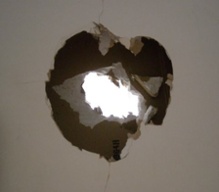
 If you live in an older home, the walls may or may not have insulation in them. After you’ve tackled all the easier-to-access parts of the building enclosure, namely the floors and ceilings, uninsulated walls would be next on the list. If you’re replacing the siding or doing a full gut-rehab, it’ll be easy to determine how much insulation, if any, insulation your home has. Otherwise, you’ll need to figure out what you’ve got, and try to do it without having to knock big holes in the wall, although that would certainly work.
If you live in an older home, the walls may or may not have insulation in them. After you’ve tackled all the easier-to-access parts of the building enclosure, namely the floors and ceilings, uninsulated walls would be next on the list. If you’re replacing the siding or doing a full gut-rehab, it’ll be easy to determine how much insulation, if any, insulation your home has. Otherwise, you’ll need to figure out what you’ve got, and try to do it without having to knock big holes in the wall, although that would certainly work.
If you live in an older home, the walls may or may not have insulation in them. After you’ve tackled all the easier-to-access parts of the building enclosure, namely the floors and ceilings, uninsulated walls would be next on the list. If you’re replacing the siding or doing a full gut-rehab, it’ll be easy to determine how much insulation, if any, insulation your home has. Otherwise, you’ll need to figure out what you’ve got, and try to do it without having to knock big holes in the wall, although that would certainly work.
Infrared cameras and borescopes allow you to do this, but you’re probably not going to rush out and buy one if you’re just a inquisitive homeowner and not a home energy pro. You could always pull off some of the switch and receptacles plates and try to look into the gap between the electrical junction box and the drywall or plaster, but often you can’t see much. If you like to live dangerously, you could stick a metal coat hanger in that gap and see if you can pull any insulation out. (Don’t do this! Also, it’s safest to turn off the electricity to the circuit where you’re doing your inspection.)
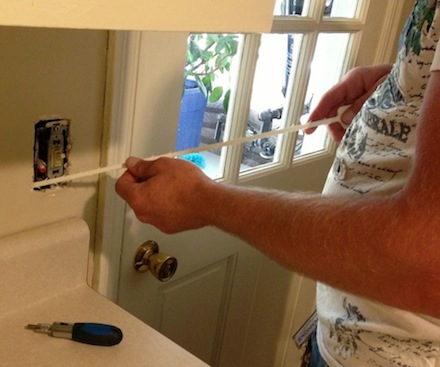
Actually, that last method, with the right tool, is a great way to go. Use a tool that’s safer than a coat hanger, however; something nonconductive. Martin Holladay recently wrote an article called Energy Upgrades for Beginners, in which he suggested using wooden chopsticks. It turns out that you can find an even better tool in the plumbing section of your local home improvement store. You can see it in action in the photos above and below.
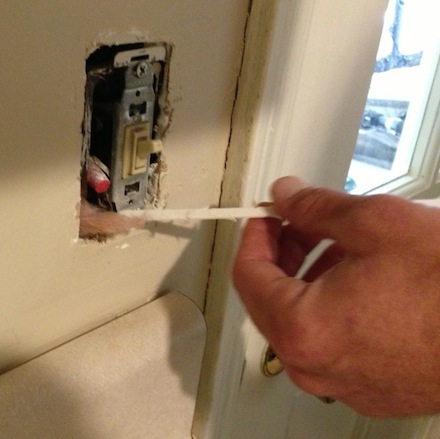
When you stick it through the gap between the electrical junction box and the drywall or plaster and then pull it back, it will snag insulation if there’s any in there. The barbs on this tool, which you can see below, are great for this job!
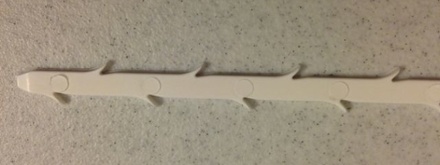
The tool is called the Zip-It, and it’s made for unclogging drains. You can get it in home improvement stores for about $2.50.
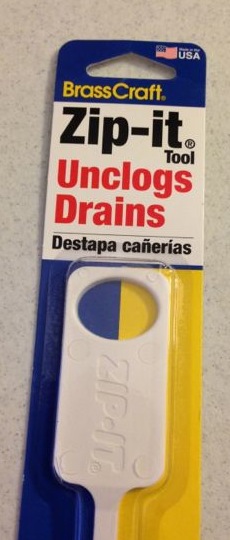
This is a tool that’s not only good for homeowners checking their own homes. It belongs in the toolkit of every home energy pro who does energy audits or home performance assessments, even those who own thermal imagers or borescopes.
Related Articles
How to Choose a Company to Do a Home Energy Audit
Cold Interior Walls, Useless Insulation, and Building Science
This Post Has 8 Comments
Comments are closed.

Thanks.
Thanks.
I will give this a try…
We have recommended plastic
We have recommended plastic darning hooks that will snag the insulation but this tool seems better suited to the task. Great stuff!
Brilliant idea! I saved a
Brilliant idea! I saved a couple of plastic crochet hooks from my Mom’s estate, but those are darn hard to find. The Zip it tool is already in my bathroom, or at the nearest big-box store.
Great post Allison, I am
Great post Allison, I am going to see if I can find them in Ottawa and get all my advisors carrying them.
larry
I’ve always used a plastic
I’ve always used a plastic knife like the kind that comes with a plate lunch.
the teeth of the kinfe catch
ins particles.
but I’m always cautious..I have a heathy respect of electricity..
David E.:
David E.: Absolutely. Improving wall insulation is usually one of the least cost-effective energy improvements to do with existing homes, but anyone doing an energy rating would still need to know if there’s insulation in the walls. It should also be part of a comprehensive report done for an energy audit.
Thanks for another great post
Thanks for another great post and valuable discussion. Basic question here: are we talking about determining only whether there is *any* insulation in the wall, or is it possible to determine from whatever shreds of material that are extracted the *level* of insulation present?
Thanks for the information.
Thanks for the information. It will be the next item in my tool box.